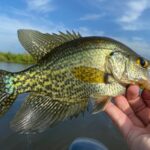Koi are a common sight in ornamental ponds and lakes across the United States. In a few parts of the country, there are also populations of wild koi. They are large and active fish and put up a good fight. So, how do you catch koi fish?
The best way to catch koi fish is to use many of the same techniques you would use to catch carp. Koi are highly intelligent fish, however, so fishing for koi requires stealth, a light line, a small hook, and the correct bait.
Table of Contents
Tips To Catch Koi
As a large and fairly common fish (especially in urban areas), koi can be a lot of fun to catch. Koi are members of the carp family, so a lot of what is true of fishing for wild carp is also true for koi. However, there are also some differences which I will talk about.
Find Out Where Koi Are In Your Area
Breeding populations of wild koi are not at all common in the United States. There are small populations in Texas and Arizona, and two lakes in Colorado were found to have massive koi infestations.
A nine-pound koi was also found in a lake in Missouri.
In some other countries, Koi have established invasive populations. In Australia, for instance, koi are viewed as a noxious invasive species.
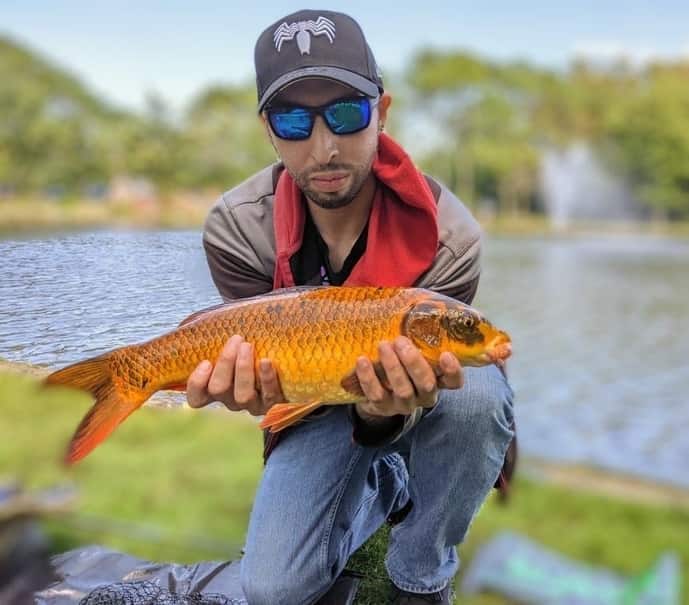
Since there aren’t significant wild breeding populations in the United States, you’re going to be most likely fishing in lakes and ponds where they have been stocked for ornamental purposes- or escaped into nearby waterways.
It’s very common for them to be stocked in water features on golf courses, both because they are beautiful and because they keep the algae, insect larvae, and weeds under control. They’re also common in both municipal and private lakes and ponds.
The best way to find out where you may want to fish for koi is to do a quick internet search for koi fishing in your area. Fishing is commonly allowed in municipal waters, so this is a good place to start.
Be Stealthy & Quiet
All carp are somewhat skittish, but Koi are even more skittish than wild carp. This is because they are very brightly colored and are easy to spot for predatory birds and other hungry animals. A koi that isn’t wary and quick isn’t going to be around long!
While koi have the same reputation as other carp for muddying the water, it’s not a fair reputation. They are actually put in ponds to improve the clarity of the water by keeping weeds and algae down. You are probably going to be going after koi in water with good visibility -all the more reason to be stealthy and careful with your approach.
While a city park whose pond has a lot of foot traffic may have less wary koi, it is best to start out assuming that you have to be careful. Stand back from the water and try not to let yourself be silhouetted by the sun. Wear clothing that blends in, and mind your shadow.
A windy day can be really good for koi fishing because the surface chop will make it hard for the fish to see you and you’re less likely to spook them when casting your bait or lure.
Use Light Line And Tackle
When fishing for Koi, you should really downsize your line and tackle size. I recommend 6-8 lb test fluorocarbon line, because it’s nearly invisible under the water and very strong.
Next, you want to use a very small hook- I would use the smallest hook you can get away with. This is usually something in the #4 to #10 size range. A standard J-hook or circle hook will work.
A good way to trick wary koi is to slide the bait up the hook, and onto the line itself. This way the fish just sees the bait but is not spooked by the hook that is trailing behind. When it swallows the bait, it takes the hook in with it.
It’s very similar to the same tactic used by trout and salmon anglers when they are feeding on spawning salmon eggs in Alaska.
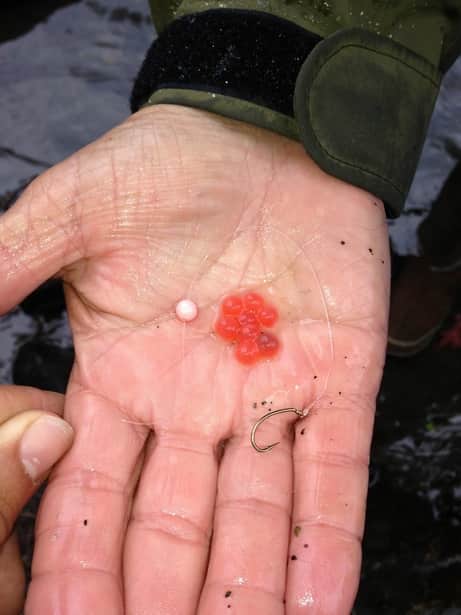
Choose The Right Bait
Koi are carp and they eat like carp. You can use any of the baits you normally use for carp, so stink baits, blood baits, dough balls, hot dogs, or any other of the nearly limitless supply of carp baits will all work just fine.
Koi really like human food. They are huge fans of canned corn, bread, tortillas, popcorn and the like. If you like it, the chances are that the koi will like it too!
If you’re fishing a pond with a lot of foot traffic, it’s common to see people feeding the koi. A good trick is to see what people are feeding them, then put some of that on your hook. If they throwing in bread chunks, fish with a bread ball!
Try Chumming The Water
Chumming is very effective for koi. In a municipal pond, other people may do it for you. If not, you can do it for yourself. For instance, if you are using corn as bait, throw a handful of corn in the water, wait a few minutes, then throw in your hook with the corn on it.
Allow the fish to get comfortable before making your approach. Use polarized glasses to find the fish…once you see them actively feeding along the bottom try casting 2-3 feet away from them and just let your bait sit.
Being stealthy and patient is the key to catching Koi- a spooked fish is very difficult to catch!
About Koi Fishing
Modern koi are descended from Asian carp. As large, brightly colored carp, they were soon noticed, domesticated, and raised by Chinese farmers as a food source. These early koi were mostly black, white, red and even blue.
The brightly colored koi we are familiar with today were developed in Japan, probably in the late 19th century, although they may be much older.
They became very popular in the United States in the early 20th century and are a feature of ornamental ponds and lakes throughout the country, with the exception of Maine, where they are restricted.
A common misconception is that koi are a variety of goldfish, which they aren’t, although they share a common ancestor. Koi can breed with goldfish, but the offspring are sterile.
Are Koi Fish Good Luck?
In many Southeastern Asian cultures, Koi has a positive reputation and is often attributed to good luck traits such as abundance, prosperity, and perseverance.
In my humble opinion, anytime you catch a fish and enjoy nature’s bounty…you should consider yourself luck!
Can You Eat Koi Fish?
Koi are carp, so they are definitely edible. Remember, their origin is as a fish cultivated for food.
Whatever recipes and techniques are used for cooking carp can also be used for cooking koi…although eating Koi is not very common in western parts of the world.
In some places like Japan, Koi are highly revered and cultivated. Eating them would be looked down upon, and in some countries, it is banned completely!
Instead, Koi are typically seen as decorative ornamental fish, and in places like New Zealand and South Africa, they are seen as a growing sportfish opportunity for anglers.
See Also: Are Carp Good To Eat?
What Do Koi Taste Like?
The meat and texture of a Koi are very similar to carp. They have very rough scales and a lot of bones that make cooking more difficult than most fish. However, if done properly the meat is firm, semi-sweet, and earthy.
Should You Eat or Keep Koi Fish?
While koi can be eaten, there are some good reasons why you may not want to.
Your koi is unlikely to be coming from a natural environment so you can’t be sure about the quality of the water it’s coming from.
Municipal ponds and lakes can have any number of ugly chemicals washing into them and even farms, golf courses, and private ponds and lakes can be getting all kinds of pesticide and fertilizer runoff.
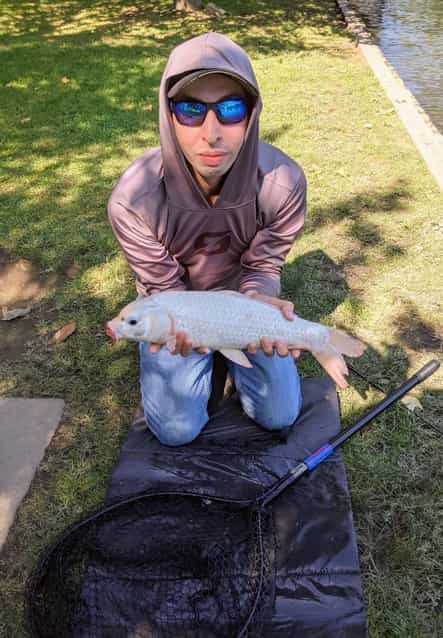
The koi you are catching probably come from a breeder who raises and sells them for ornamental purposes. Unfortunately, a lot of these breeders give them chemicals to enhance the colors, so you probably don’t want to be eating it.
Lastly, koi can be really valuable fish, uneaten. In the United States, some koi sell for thousands of dollars! A lot of people who fish for koi, do it to get stock for their own ponds or to check it off there multi-species list.
Thanks for Reading.
You May Also Like: Carp vs Bass: Friendly Duo Or Harmful To Fishing?
If you haven’t guessed yet, I love fishing and everything about it!
To learn more about why I started Panfish Nation, visit the About page and follow along on Social Media:


Download a copy of my FREE Lure Color Selection Chart & Knot Guide!
Stay up to date with fishing reports, tackle reviews, industry news, and much more! We respect your privacy, unsubscribe at any time.
- Crazy Facts About the World Record Crappie

- What Size Hooks for Smallmouth Bass? Quick Guide

- Large and in Charge-Mouth: 10 of the Best Bass Lures of All Time (And Where to Buy Them)

- Emperor of the Sun(fish): What You Need to Know About the World Record Bluegill
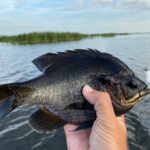
- The Seven Best Lures for Fall Bass Fishing
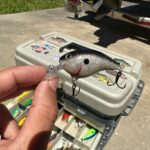
- Which Fishing Line is Best for Bass Fishing With A Spinning Reel?
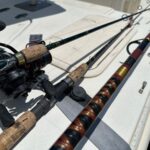
- What Size Hooks for Panfish?
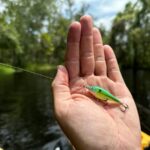
- Coppernose Bluegills: How They’re Different from Common Bluegill
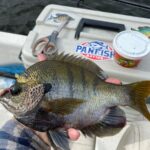
- Best Crappie Lakes In North Carolina
